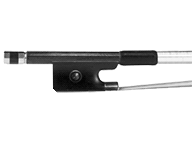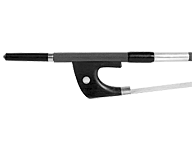Your shopping cart is currently empty.
If you have not already done so, you can login to your account to see any items that may be saved in your cart. Once logged in, you may also add items to the cart that you saved previously to your wishlist.
These are general guidelines for help in determining the correct instrument size. The best option is to have the teacher size the student, and always defer to the teacher's judgment in sizing. It is important for the player to be comfortable to avoid issues that may develop over time from playing an improperly sized instrument.
The chart below is a good guideline for violin sizing. Have the player stand with left arm fully extended to the side, then measure the distance from the neck to the middle of the palm. Refer to the chart to determine the best size. The student's age may also give you some idea of the size. Remember that everyone grows at a different rate. It is important for the player to be comfortable to avoid physical issues.
When supporting the instrument under the chin in playing position, if the instrument is the proper size, the palm and fingers of the left hand should be able to comfortably cup the scroll.
| Violin Size | Arm Length | Player's Age |
|---|---|---|
| 1/16 | 14"-15" | 3 to 4 years old |
| 1/10 | 15"-17" | 4 to 5 years old |
| 1/8 | 17"-18" | 5 to 6 years old |
| 1/4 | 18"-20" | 6 to 7 years old |
| 1/2 | 20"-22" | 8 to 9 years old |
| 3/4 | 22"-23" | 10 to 11 years old |
| 4/4 | 23"+ | 12 years and older |
7/8 size violins are also available by special request. These are sometimes used by smaller adults or people with small hands.
These are general guidelines for help in determining the correct instrument size. The best option is to have the teacher size the student, and always defer to the teacher's judgment in sizing. It is important for the player to be comfortable to avoid issues that may develop over time from playing an improperly sized instrument.
Violas smaller than 12" tend to be very hard to play because of the short scale length. The strings will be very loose, and hard to bow. String makers are working on better technology to accommodate small violas, but for now it may be better to start on a ¼ (or smaller) violin rather than an 11" viola. As always, consult with your teacher to determine the best way to suit the player's needs.
The chart below is a good guideline for viola sizing. Have the player stand with left arm fully extended to the side, then measure the distance from the neck to the middle of the palm. Refer to the chart to determine the best size. The student's age may also give you some idea of the size. Remember that everyone grows at a different rate. It is important for the player to be comfortable to avoid physical issues.
When supporting the instrument under the chin in playing position, if the instrument is the proper size, the palm and fingers of the left hand should be able to comfortably cup the scroll.
| Viola Size | Arm Length | Player's Age |
|---|---|---|
| 11" | 18"-20" | 5 years and under |
| 12" | 20"-22" | 6 to 9 years old |
| 13" | 22"-23" | 6 to 9 years old |
| 14" | 23"-25" | 9 to 11 years old |
| 15" | 25"-26" | 11 to 12 years old |
| 16" | 26"-27" | 13 years to adult |
| 16.5"+ | 27"+ | large adult |
There are also a few sizes of viola not listed. For example; some people use 15½" violas for someone who is fully grown or nearly so, but does not quite fit into a 16" viola. As the viola evolved from an instrument played on the lap to an instrument played on the shoulder it is naturally a little larger than is comfortable on the shoulder. Violists often try to play the largest pattern they can manage, but too large of an instrument will cause physical injury over time with frequent playing. Student models are more limited in sizing, but the instruments don't fall quite as neatly into 1-inch increments as one might guess. If you have trouble finding a comfortable instrument let us know, and we will do what we can to help.
These are general guidelines for help in determining the correct instrument size. The best option is to have the teacher size the student, and always defer to the teacher's judgment in sizing. It is important for the player to be comfortable to avoid issues that may develop over time from playing an improperly sized instrument.
To size an instrument, the player should sit so that the knees are bent at a 90 degree angle. The instrument should rest such that the upper rim rests on the sternum and the left knee contacts the curve below the lower bout corner. The C-string peg should be near the left ear, with the neck a few inches from the shoulder, and the left hand should be able to reach both ends of the fingerboard with ease. The first and fourth fingers of the left hand should be able to comfortably span a major third on the D string.
| Cello Size | Height | Arm Length | Finger Span | Player's Age |
|---|---|---|---|---|
| 1/16 | under 4 years old | |||
| 1/10 | 4 to 5 years old | |||
| 1/8 | 3.5 to 4 feet | 4 to 6 years old | ||
| 1/4 | 3.5 to 4 feet | 18" to 20" | 3" to 4" | 6 to 8 years old |
| 1/2 | 4 to 4.5 feet | 20" to 22" | 4" to 5" | 8 to 10 years old |
| 3/4 | 4.5 to 5 feet | 22" to 24" | 5" to 6" | 10 to 12 years old |
| 4/4 | 5+ feet | 24" and up | 6"+ | 12 years and older |
7/8 size cellos are also available by special request. These are sometimes used by smaller adults or people with small hands.
Bass sizing is less standard than many other instruments, so it is difficult to give hard and fast rules for sizing students. See the age charts below for a rough guideline, but double-check the size with your teacher. It is important for the player to be comfortable and not struggle with an improperly sized instrument. The standard size bass for adults is ¾. 7/8 and 4/4 size basses are made, but less commonly used.
With an instrument in hand you can check the size as follows; when the player and bass are both standing upright the bridge should be about the same height as the player's right hand and the fingerboard nut should be opposite the forehead near eye level. The student should be able to reach the end of the fingerboard easily.
| Bass Size | Height | Player's Age |
|---|---|---|
| 1/8 | 3.5 to 4 feet | 5 to 7 years old |
| 1/4 | 4 to 4.5 feet | 7 to 9 years old |
| 1/2 | 4.5 to 5.5 feet | 9 to 13 years old |
| 3/4 | over 5 feet | over 13 years old |
Bass bows come in one of two styles: French or German. Each has its own shape and is held differently. The French bow is held like the bows of other orchestral string instruments, while the German bow is held with an underhand grip. If you do not know what type of bow to get, please ask your music teacher.
This is what a French bow looks like: |
This is what a German bow looks like: |
Determining the correct size guitar is difficult, as there is no simple measurement to take. See the age chart below for a rough guideline, but it is recommended that you seek guidance from your music teacher.
| Guitar Size | Player's Age |
|---|---|
| 1/2 | under 12 years old |
| 3/4 | 12 to 14 years old |
| 4/4 (full size) | over 14 years old |